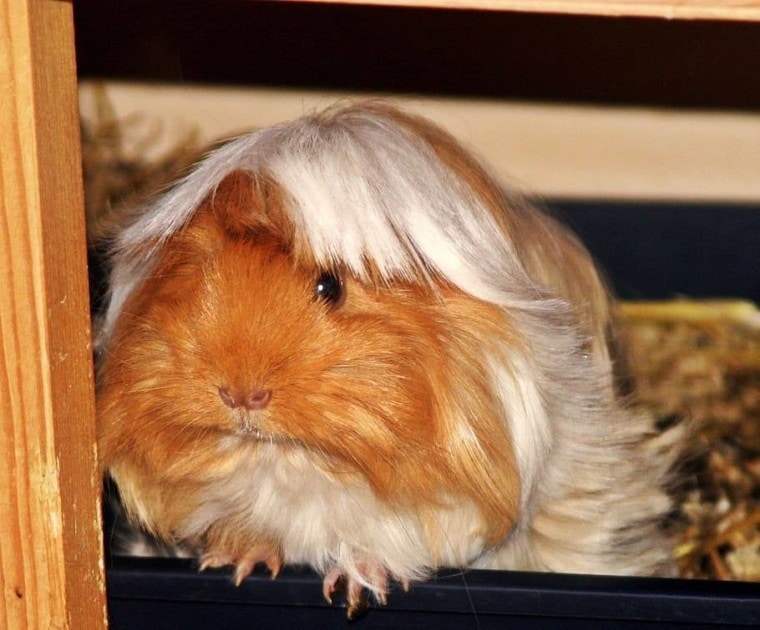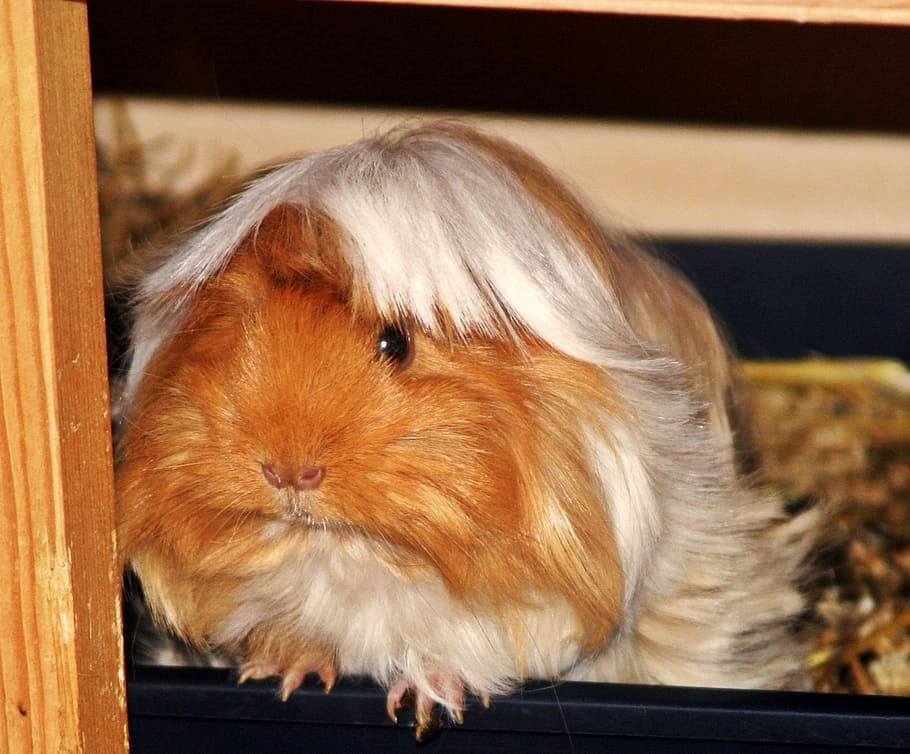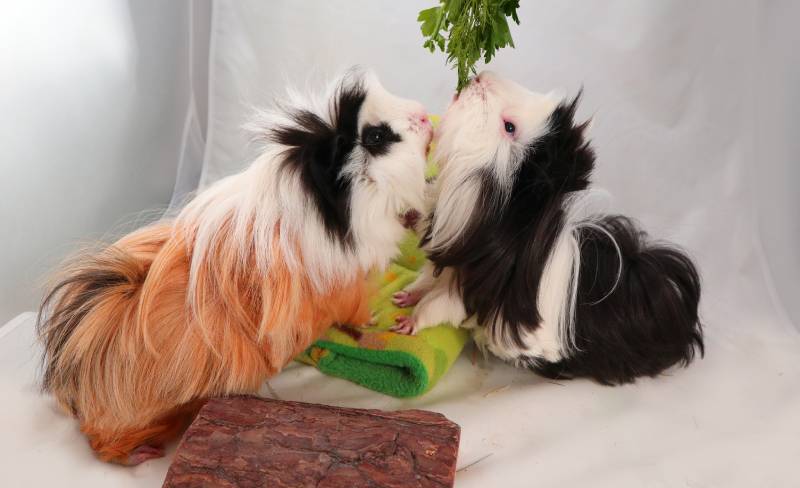
Click to Skip Ahead
Peruvian guinea pigs are some of the most adorable, sweetest, and playful guinea pigs on the planet. They’re bold, curious, and have gorgeous coats; you would be lucky if you decided to give a Peruvian guinea pig a forever home.
The Peruvian is considered the longest-haired guinea pig of all the breeds and was initially bred as a show animal. They’re available in various colors, including tri-colored, white, brown, russet, and even gray, to name a few. In the guide below, we’ll discuss everything you need to know about the Peruvian guinea pig, so keep reading.
| Size: | Standard |
| Weight: | 1 to 3 pounds |
| Lifespan: | 6 to 8 years |
| Similar Breeds: | Abyssinian |
| Suitable for: | Experienced guinea pig owners |
| Temperament: | Alert, curious, playful |
While the Peruvian guinea pig is playful, curious, alert, and easy to handle, their long hair requires a lot of grooming and care. That’s why we recommend this guinea pig breed be with experienced guinea pig owners.
If you’re considering adopting a Peruvian guinea pig as your very own, there are a few aspects you need to consider first. We’ll briefly review their adoption fees, temperament, and intelligence, and then examine their care requirements in more detail.
Peruvian Guinea Pig Breed Characteristics
How Much Do These Guinea Pigs Cost?
The Peruvian guinea pig was originally bred as a show pig. They’re considered one of the rarest long-haired guinea pigs among the White-Crested guinea pig family. Still, even though they’re rare, the Peruvian will only run you $30 to $40 to purchase, depending on where you buy your cavy.
However, it’s also important to note that the purchase price isn’t all you’ll pay for your Peruvian guinea pig. There will be the cost of setting up an enclosure, feeding them, and providing them with toys and treats as well. You also need to factor in vet checkups, grooming, and other expenses.
The cage alone can run you anywhere from $90 to $200, so you’ll want to add these costs into your budget before you decide whether to give a Peruvian guinea pig a forever home.

Temperament & Intelligence of the Peruvian Guinea Pig
It’s not only the gorgeous long fur of this guinea pig that makes them popular; it’s also the pig’s larger-than-life personality that draws guinea pig owners in. They are known for being playful and affectionate, and unlike other cavies, they love to cuddle with their pet parents whenever they can. However, you must keep an eye on them when they’re away from their cage because they’re curious and bold to the point of being nosy and getting into everything if they aren’t watched carefully.
If you adopt two Peruvian guinea pigs and they get bored, they may start chewing on each other’s fur. Therefore, keeping them mentally stimulated with toys and allowing them to explore the environment is vital to their health.
Do These Guinea Pigs Make Good Pets?
You would think that with the outgoing, charming, and affectionate personality of the Peruvian Guinea Pig that it would make the perfect pet for a beginning guinea pig owner. While the breed is easy to handle, the extensive amount of grooming the animal requires makes it a better choice for experienced guinea pig owners.

Does This Guinea Pig Get Along with Other Pets?
The Peruvian is a social guinea pig, and it’s recommended that you always have a couple of them together, as they love to play with their companions. However, letting your guinea pig lose when you have dogs and cats around might not be the best idea. Your other animals might see your guinea pig as prey and injure your pet even if they don’t mean to. You can try to train and socialize your pets to get along with your guinea, but you’ll still need to supervise playtime to prevent confrontations.
Things to Know When Owning a Peruvian Guinea Pig:
Now that you know how much your Peruvian guinea pig will cost, including their setup and food, you might be ready to rush out and purchase one. However, you still need to know a few things about caring for your furry friends, such as food, diet, and enclosure requirements.
Food & Diet Requirements 🥕
Since the Peruvian guinea pig has such long fur, it’s essential that you feed them food that contains plenty of omega-3 fatty acids. The food you give your guinea should help keep the guinea’s skin and coat healthy and shiny. Grass hay is essential to their diet; it maintains a healthy digestive system and keeps their teeth filed down.
You can also provide high-quality pellets with plenty of vitamin C included, as guinea pigs don’t produce their own vitamin C. They also require leafy, green veggies and can eat fruit occasionally. Fruits should only be served once a week because most fruits have a high sugar content, which can affect your guinea’s health.

Habitat & Enclosure Requirements 🏡
All guinea pigs need a large enclosure, and the Peruvian is no exception. The bigger your guinea’s enclosure, the better off your furry friend will be. The minimum cage size is 30” x 36” for one guinea pig, but purchasing the biggest cage possible is best. The cavy needs a lot of space to play, forage, and exercise and should be allowed to roam free in your home while you supervise.
Exercise & Sleeping Needs 🐹
Guinea pigs take brief naps throughout the day but only sleep around 4 hours daily. Their cage should be kept warm and dry and include comfortable bedding and plenty of hay. As with any guinea pig, exercise is essential to ensure they stay healthy and happy.
Mental and physical stimulation is essential so the guinea pig doesn’t get bored and chew on their fur or the fur of their companions. While many small animals, such as hamsters, rats, and gerbils, enjoy running on a wheel, it isn’t safe for a guinea pig.
Most of their daily exercise can include play sessions with you and your family. However, as mentioned, Peruvian guinea pigs are curious pets and need to be supervised when allowed to roam free. To keep them safe, secure all your wires, cables, and other items they may be tempted to chew on.
Training
While you shouldn’t expect your guinea pig to do tricks or backflips, they are intelligent and can be taught many basic actions. You should be able to train your guinea to come when you call and even to use the litter box in many cases. It will take time, patience, and love to teach your guinea pig the commands, but it’s worth it.
Consistency and positive reinforcement are key and will help you achieve your task faster. It’s important to never yell at or punish your guinea pig when trying to train them since that will have the opposite effect and could possibly make your guinea pig afraid of you.

Grooming ✂️
Their Grooming is why we don’t suggest a beginning guinea pig owner give this guinea pig a forever home. Since the Peruvian Guinea Pig has very long fur, it takes a lot of effort and time to keep their fur healthy, shiny, and free of mats and tangles. It’s best to groom and brush your guinea pig’s fur daily.
If you neglect your guinea pig’s grooming needs, its fur will quickly become matted and knotted. A mat that is left tangled can lead to health problems, skin problems, and possibly infections in your furry friend. Not only that, but it can also restrict the movement of your guinea and cause the animal to stop eating and even grooming.
It’s also a good idea to cut your guinea’s fur occasionally, as it can get extremely long if left unattended. You can also tie back your guinea’s hair if you’re not going to cut it. If you feel that you can’t keep up with your Peruvian Guinea Pig’s grooming needs, you can take them to a professional groomer.
Lifespan and Health Conditions 🏥
As with any pet, there are health conditions that you need to watch out for with your Peruvian guinea pig. These guineas usually live between 6 and 8 years if they are properly cared for. The best way to care for your guinea is to take them in for regular checkups with your vet. However, we’ll list the most common serious and minor health conditions.
If you notice any signs of the above conditions in your Peruvian guinea pig, it’s best to take the guinea to the vet for diagnosis and treatment right away.
Male vs. Female
There aren’t very many differences between the males and females of the Peruvian breed. However, the males are a bit larger than the females. Also, the male genital area resembles an “I” shape, while the female genital area resembles a “y” shape.
Male guinea pigs are called boars, and female guinea pigs are called sows. Also, the females are said to be shy and more skittish, whereas the males are bolder and tend to be more confident. Male guineas are also said to be more territorial than their female counterparts.
3 Little-Known Facts About Peruvian Guinea Pig
Now that you know everything there is to know about the Peruvian guinea pig, you’ve probably decided to give one a forever home. In the next section, we’ll give you a few little-known facts about this breed.
1. Peruvian Guinea Pigs Are Prone to Heat Stress
Peruvian guinea pigs are prone to heat stress. They have such long hair that hot climates can make them sick. If you live in a hotter climate, ensure the Peruvian is kept inside with the air conditioner running during summer.
2. Peruvian Guinea Pigs Are Better in Pairs
Peruvian guinea pigs are social pets, so purchasing them in pairs is always better. If you have two of these delightful creatures, they can keep one another occupied when you’re too busy to play with them. However, it is important to keep them mentally and physically stimulated with toys, as they’ll start chewing one another’s fur if they get bored.
3. Peruvian Guinea Pigs Are Active 20 Hours a Day
Peruvian guinea pigs, like other guinea pigs, are active for 20 hours daily. They take several naps that only last 15 to 30 minutes.

Final Thoughts
The Peruvian guinea pig makes an excellent pet for owners experienced with guineas. While the breed is laid-back, energetic, and quite curious, they have extensive grooming needs. Since they are social animals, it’s best for them to have a friend to play with. Luckily, Peruvians aren’t expensive animals, and as long as you provide healthy food, a comfy enclosure, and plenty of daily exercise, they’ll thrive and entertain you for several years.
Still searching for the perfect Guinea Pig breed for your home? Check out these breeds as well:
Featured Image Credit: Pongpat Thongwattanaporn, Shutterstock







